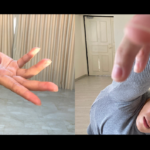Defunct Mnemonics
2012 - Sculpture (Sculpture)
Peter Robinson
Defunct Mnemonics (2012) plays off woodworking traditions found in indigenous art in order to create a body of formally minimal objects that are both beautiful in their restraint and profoundly moving in their associations with the totemic. Resembling large pick-up-sticks, the complete work is comprised of 126 vertical sculptures wrapped in fabric with alternately monochromatic and graphically patterned dyes and prints. Leaning against a wall and arranged side-by-side, they could be mistaken as highly decorated mallets for use in an undetermined ritual or game. These associations with faith and repetition are entirely intended: as part of Robinson’s process, each sculpture was hand carved and finished based on a case of spirit sticks housed at the Museum of New Zealand Te Papa Tongarewa, New Zealand’s national museum and art gallery in Wellington. In order to produce another layer of tactile experience and texture, Robinson wrapped every stick in a roll of concentric felt, in some cases switching between fabrics as means of creating a richly heterogeneous finish to the work. The visual and aural codes at play in Defunct Mnemonics are a reminder of how repetition can help us order ourselves through more deeply felt rhythms. At once both playful and meditative, Robinson’s work encourages us to slow down and retrain our focus through considered visual and metaphorical stops and starts.
Peter Robinson is an artist whose work explores the various cross-sections between materiality, identity, and the indigenous. Many of his works utilize motifs found in Maori art, and his use of woodworking and felted wools often riff on culturally specific materials based in communal craft practices. His clean lines and deliberately restrained forms, though, could be easily placed alongside Minimalist sculpture and feel unselfconsciously modern. Robinson studied at the Ilam School of Fine Arts and has exhibited extensively throughout New Zealand. In 2001, his work was included in the exhibition bi-polar at the Venice Biennale.
Colors:
Related works sharing similar palette

© » ARTS EQUATOR
Purⓔ《纯ⓔ》: How do we talk about Art Form X? | ArtsEquator Thinking and Talking about Arts and Culture in Southeast Asia ArtsEquator Viewpoints Courtesy of M1 CONTACT July 13, 2020 By Jocelyn Chng (1,800 words, 4-minute read) When I accepted the opportunity to write this piece on Purⓔ 《 纯 ⓔ》 , I did it feeling a bit like a shipwreck survivor re-approaching water for the first time...

© » ARTNEWS RETROSPECTIVE
Mary Weatherford Revisits an ARTnews Profile of Joan Mitchell – ARTnews.com Skip to main content By Alex Greenberger Plus Icon Alex Greenberger Senior Editor, ARTnews View All September 4, 2020 10:27am ©ARTnews In 1957, art critic Irving Sandler paid a visit to the studio of painter Joan Mitchell , an Abstract Expressionist known for her brushy images capturing nature...

© » KADIST
Allora & Calzadilla
This installation combines the display of real objects with the deceptively painterly amalgamation of their content as the subject of a photograph...

© » KADIST
Colter Jacobsen
2010The title Untitled Passport II was first used by Felix Gonzalez-Torres in an unlimited edition of small booklets, each containing sequenced photographs of a soaring bird against an open sky...

© » KADIST
Allen Ruppersberg
1970Untitled (City Limits) is a series of five black-and-white photographs of road signs, specifically the signs demarcating city limits of several small towns in California...

© » KADIST
Milena Bonilla
2009Milena Bonilla’s discursive practice explores connections among economics, territory, and politics through everyday interventions...

© » KADIST
Michelle Handelman
2009In Dorian, a cinematic perfume, video is used as a community gatherer, a tool to speak about particular subcultures, in this case the trans-gender drag queen New York community, past and present...

© » KADIST
Mariana Castillo Deball
Mariana Castillo Deball’s set of kill hole plates are part of a larger body of work problematizing archeological narratives, and drawing attention to the conservation process and its role in recreating an imagined object...

© » KADIST
Gan Chin Lee
In Studies of Chinese New Villages II Gan Chin Lee’s realism appears in the format of a fieldwork notebook; capturing present-day surroundings while unpacking their historical memory...

© » KADIST
Nazgol Ansarinia
2013In the early 2000s, as urban redevelopment accelerated and intense construction significantly diminished public space in Tehran, state-funded murals began to represent imaginary landscapes on building facades...

© » KADIST
Zhang Kechun
2011Zhang Kechun’s photographic series The Yellow River documents the effects of modernization along the eponymous Yellow River, the second longest in Asia...

© » KADIST
Nicolás Paris
2012Nicolas Paris studied architecture and worked as an elementary school teacher before he decided to become an artist...








